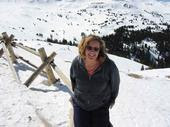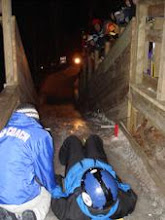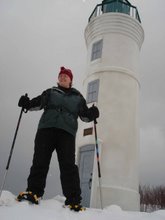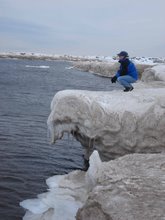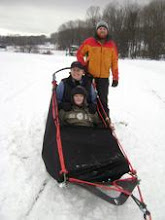Sunday, February 16, 2014
Walking on Water...
It's been a cold and snowy winter in Michigan. The coldest and snowiest that I remember in my adult life - and probably, for most of my childhood (although I was alive during the "blizzard" of 1978, I don't really remember it). It's been so cold that nearly 90 percent of the five Great Lakes combined are ice covered as of Thursday, February 13 (according to the Great Lakes Environmental Research Lab). That's some serious ice-ice, baby!
I've had the opportunity to walk and snowshoe along the frozen shoreline many times over the past few years -- Muskegon, Frankfort, Empire -- but I've never seen ANYTHING like what I experienced yesterday in South Haven. Snow and ice for as far as the eye could see -- for miles to the south, north AND west. The normally sugar-sand beaches were covered in rolling hills of snow, ice chunks and mountainous mini caves leaving one to question whether they were at the lake or on some desolate planet.
Nearly as impressive as the landscape were the crowds of people out exploring this natural winter phenomenon. People were scraping away the snow to see the thick, white ice below. They were walking the pier to the bright red lighthouse. They were walking out great distances from the shore, posing, taking photos, taking photos of others taking photos, talking with each other about how incredibly crazy this all was. It's hard to really capture and explain the essence of what was going on out there -- in terms of the conversations that were had between total strangers and the shear expanse of it all.
Yesterday - I truly was one of dozens, no - hundreds, who literally walked on water (albeit frozen) in a way we probably never will again. It's unlike anything I have experienced before...and perhaps, ever will again.
Great Lakes Ice Facts
The Great Lakes, which hold nearly one-fifth of the surface fresh water in the world, are almost completely frozen over after an unusually cold winter.
As of Thursday, nearly 90% of the lakes are under a cover of ice, according to the Great Lakes Environmental Research Laboratory.
The last time they came this close to being completely frozen over was in 1994, when 94% of the lakes’ surface was ice.
If the rate at which ice has been growing continues, an all-time record could be set later this month.
“In the last one to two weeks, we’ve seen rapid accumulations on Lakes Superior, Huron and Michigan,” Michigan State University associate professor and state climatologist Jeff Andresen said.
The freeze is a major reversal from last year, when the five lakes only reached 38% ice cover.
The lakes’ water supply has been far below average in recent years, and the ice could prove beneficial by slowing evaporation and shutting off lake-effect snow.
Lake Michigan Facts
Lake Michigan is the third largest Great Lake by surface area and the sixth largest freshwater lake in the world.
Lake Michigan Length: 307 miles / 494 km.
Lake Michigan Lake Michigan: 118 miles / 190 km.
Lake Michigan Average Depth: 279 ft. / 85 m
Lake Michigan Maximum Depth: 925 ft. / 282 m.
Lake Michigan Volume: 1,180 cubic miles / 4,920 cubic km.
Lake Michigan Water Surface Area: 22,300 sq. miles / 57,800 sq. km
Lake Michigan Shoreline Length(including islands): 1,638 miles / 2,633 km.
Lake Michigan Elevation: 577 ft. / 176 m.
Lake Michigan Retention / Replacement Time: 99 years
Where Lake Michigan got its name:
Champlain called it the Grand Lac. It was later named "Lake of the Stinking Water" or "Lake of the Puants," after the people who occupied its shores. In 1679, the lake became known as Lac des Illinois because it gave access to the country of the Indians, so named. Three years before, Allouez called it Lac St. Joseph, by which name it was often designated by early writers. Others called it Lac Dauphin. Through the further explorations of Jolliet and Marquette, the "Lake of the Stinking Water" received its final name of Michigan.
Another story recounts that Nicolet, the first European to set foot in Wisconsin in 1634, landed on the shores of Green Bay and was greeted by Winnebago Indians, whom the French called "Puans." Lake Michigan was labeled as "Lake of Puans" on an early and incomplete 1670 map of the region that showed only the northern shores of the lake. However, only Green Bay is labeled as "Baye de Puans" (Bay of the Winnebago Indians) on maps from 1688 and 1708. On the 1688 map, Lake Michigan is called Lac des Illinois.
An Indian name for Lake Michigan was "Michi gami."
For more photos: https://www.facebook.com/PromoteMichigan
Labels:
frozen great lakes,
great lakes,
lake michigan,
michigan,
pure michigan
Subscribe to:
Posts (Atom)






